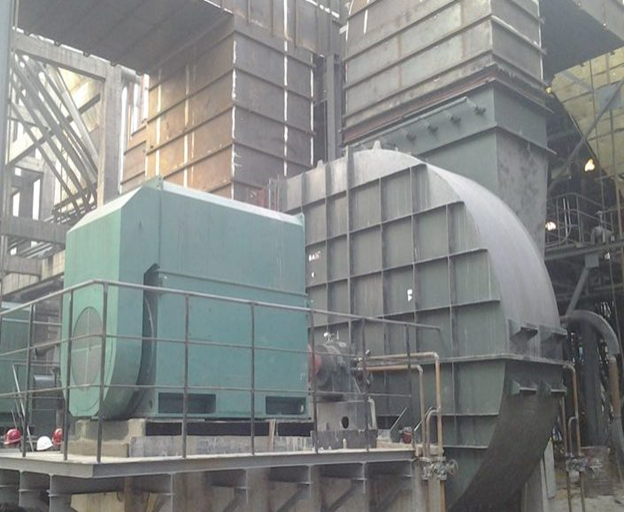
Fans are a very common component in industry, they are used to move air from one place to another. Fans are used in dust collection, supplying air to boilers, providing ventilation to factories, are used in the manufacturing process and more. Even your HVAC system at home has a fan/blower in it to move the heated/cooled air through the duct work throughout the house keeping everyone comfortable.
Understanding the equipment you are inspecting/servicing will always be beneficial to the maintenance technician. This issue of “Know Your Machine”, series of articles, begins with the basics of fan operations, their components, and their failure modes.
Fan Configurations
Fans will be setup in one of the following three configurations:
- Direct Drive – With the fan mounted on the motor shaft.
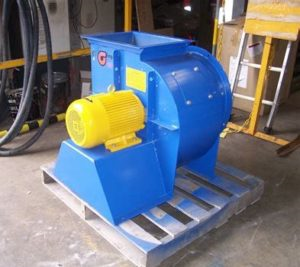
2. Coupled – A coupling between the motor and the fan shaft with the fan rotor being either overhung (offset to the shaft bearings) or center hung (between the shaft bearings).
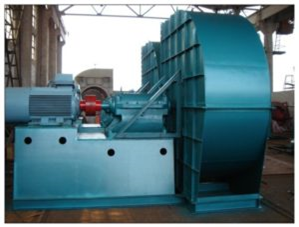
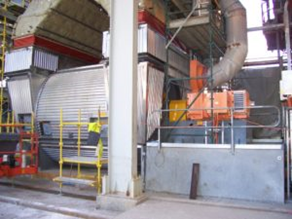
- Belt Driven – With a sheave/pulley on both the motor shaft and the fan shaft with either a V-belt or Positive Drive Belt in between. The fan rotor can be either overhung or center hung in this configuration as well.
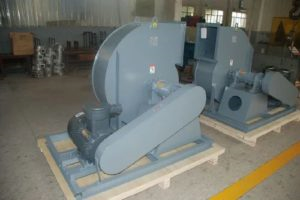
Setup and Maintenance Challenges
Each configuration has its own setup and maintenance challenges that we need to be aware of.
On a Direct Drive Fan, the rotational force of the fan is applied directly to the motor shaft bearings. There is no belt or coupling so there is very little energy loss from the motor to the fan. This configuration is used on small fans with a light load.
A Direct Coupled Fan will usually have a high load rating; these are often found on larger fans or fans that require the driving force to be higher than what can be expected from a belt drive. This fan assembly will typically have the motor, a coupling, and two fan bearings. The fan bearings are carrying the weight of the fan rotor and are subjected to most of the rotational forces, the coupling and motor do take some wear as the fan vibration levels increase. It is possible for the shafts to act as a lever and cause increased vibration on the motor where the fulcrum would be placed on the coupled side fan bearing or coupling itself.
Belt Driven Fan assemblies have a motor which drives a belt through the use of sheaves on both the motor and fan shaft which is usually supported by two bearings. The fan bearings in this assembly will, in many cases, be held in pillow block housings. The motor is often “protected” by the belt when it comes to vibrational forces produced in the fan, but in some instances the belt can produce its own forces causing the motor additional wear from the belt or sheaves being out of specification.
Fan Components
This brings us to the components that make up a fan. Which are as follows:
- Motor
- Sheave
- Coupling
- Fan Bearings
- Fan Rotor
The Electric Motor will either be variable speed or run on a fixed speed. It is most commonly an AC Non-synchronous motor and can be subjected to all electrical faults associated with the type of motor present. Motors driving a fan via a belt can be highly affected by belt tension, as over tensioning the belts will increase the load on the motor bearings.
This is especially true if the motor has a ball bearing in the sheave end position as opposed to cylindrical roller bearings that can handle a higher radial load. Misalignment in either a belt driven or coupled configuration will cause increased load on the motor bearings as well – significantly decreasing the expected L10 bearing life.
The Sheaves on the motor shaft, and the fan shaft, play a crucial role in the equipment performance on a belt driven fan. Worn sheaves will decrease the life of the belt resulting in extra maintenance to be performed. Misalignment will also reduce the life of the belt as well as add additional stresses to both the motor and fan shaft bearings. Eccentric sheaves will cause a high running speed vibration with a very stable phase, where the impacting is occurring in the same position with every revolution of the shaft. This too can be very damaging to the other components of the fan.
On coupled fan assemblies with two fan Bearings, we are primarily focused on proper shaft alignment. The coupling transfers the power from the motor to the fan, and therefore carries high rotational forces that when misaligned, worn, or eccentric, can result in damage to the other components.
The fan bearings support the weight of the Rotor and distribute it across the bearing rolling elements and raceways.
Bearing and Housing Considerations
There are a few important factors to keep in mind when we consider the fan bearings and their housings:
- Lubrication. Consider the environment, if it is dirty and contamination is a high risk, we might want to use grease and make sure to apply the recommended amounts more frequently (perhaps ½ as much twice as often) this would help keep contaminants out of the bearing assuming proper cleanliness and control practices are being followed. If the fan is running in a hot environment, you may want the fan bearings running on circulating oil instead of grease to help reduce the temperatures present in the bearing.
- Bearing Configurations on this type of setup can include a “fixed” and a “floating” bearing, the configuration can change, and you should reference the OEM for properly positioning the bearings, but typically the fixed bearing is near the coupling or belt sheave to prevent thermal growth of the rotor and shaft from having an effect on the alignment.
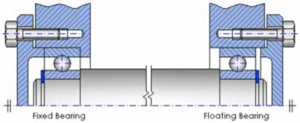
3. Split Housings that are used for fan bearings are factory ground as matched sets and the caps are not interchangeable. Interchanging matched split housing caps can result in a loose bearing fit in the housing. This is a common assembly error.
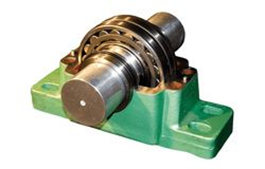
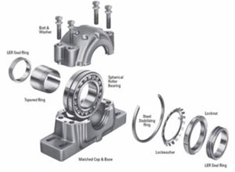
- The Fan Rotor is a “wheel” that when rotated produces both the forces to push/pull the air which creates the load on the motor, coupling/belt, and the fan bearings.
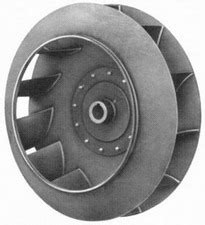
The fan rotor is subject to buildup, rust, and wear over time. A fan rotor will generate a significant amount of vibration if it is not well balanced around its radius. Prior to performing a balance on a fan rotor, it is very important to make sure that it is clear of debris and significant wear that could cause a fan that has been in service to “lose” its balance.
Fans with significant rust or are damaged to a point where it would be unsafe to run should be replaced/repaired before performing a dynamic balance on it. Another item to look for on the fan rotor are clean/shiny spots which could indicate the occurrence of a rub, or a possible location where a weight is missing.
Failure Modes in Fans
Fans fail in a variety of ways as the motor, sheave, belts, fan bearings, and fan rotor produce a significant amount of rotational energy. The energy is intended to be used to push/pull air, but if components are worn/damage, etc. that energy is lost to heat and/or further wear to one or more of the components.
Below are some common failure modes on fans, and tips on how to improve reliability of this machine type
- Structural Issues can have a higher impact on fans due to the fact that it will be excited by any unbalance that may be present on the fan rotor. Make sure the base and base bolts are tight on all structural components.
- Unbalance presents itself as a 1x running speed vibration, there are many other vibrational problems that have a similar signature. Soft foot, structural looseness, eccentric sheaves, misalignment, and unbalance look very similar in the vibration spectrum. If you have one of these other issues, it could make balancing the rotor difficult if not nearly impossible.
- Fan Lubrication and environmental issues like those mentioned above are common in fans and need to be addressed appropriately.
- On belt-driven fans, the power is transferred through the sides of the sheave, not the bottom. Perform a visual inspection on sheaves every time you replace a belt and check for Runout in both the axial and radial directions.
- Make sure you position the Fixed and Floating Bearings in their OEM recommended locations.
- Bearing Caps are specific to the bottom of all split housings, mixing them up will dramatically reduce the life of the bearing inside.
Periodic vibration checks will provide an early indication of wear/unbalance allowing time to schedule repairs, check all critical fans at least once a month to provide good reliability on all your fans.
Knowing your fan speed, how fast the fan is turning will determine how much energy is present on the unit and it will increase the forces to other components exponentially. When assigning criticality to a scheduled repair – speed is one of the most important factors to consider.
You will encounter many fans in your maintenance career and knowing how they work and how they fail will help you to significantly improve the reliability of this often-critical component.
__
Are you looking to identify faults and balance the fans in your facility? If so, then the Falcon portable vibration data collector is your sidekick for keeping your fans in top condition. To learn more about the Falcon, go to: https://acoem.us/solutions/falcon/















